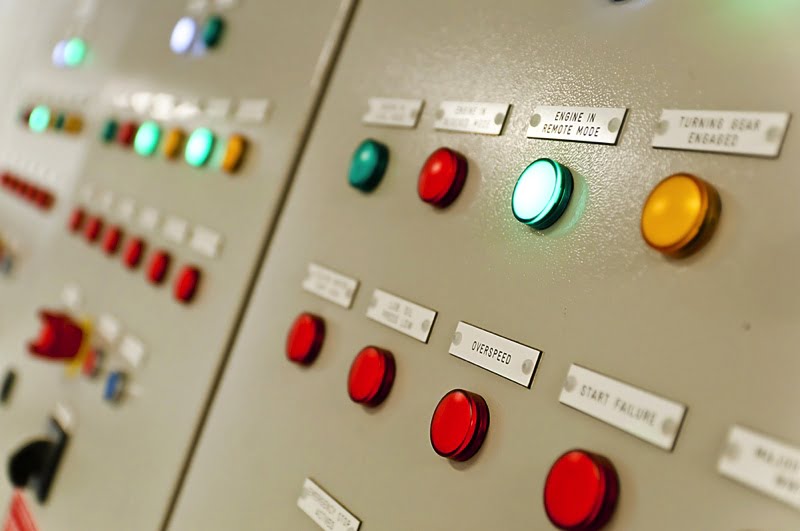How Temperature Control Affects Control Panel Design

Control panel designers face an ongoing conflict between meeting the technical requirements for electrical control panels and budget allocations. On the one hand, there’s the desire to choose generously sized control panels that optimize the layout of electrical equipment and, on the other, the need to exercise tight cost restraints that inevitably mean compromises are made. There’s also the need to consider the space that’s available in the plant as well as the environmental conditions that are present.
One of the biggest challenges is to manage the enclosure temperature and ensure the heat distribution inside the control panel is such that equipment temperatures are kept within specification.
Equipment Layout
It’s best to keep heat sensitive equipment well away from heat generating components such as VFDs. In turn, VFDs need an adequate flow of cool air and the hot air discharged should be directed back to the enclosure cooling system or through vents.
In an ideal world, VFDs would be separated from other equipment, but this is not practical and care must be taken to ensure the heat generated by these drives does not adversely affect other equipment. It is advantageous to place these units as close to the enclosure cooling system as is practical to maximize cooling and to minimize the risk of overheating sensitive equipment.
Heat Load
The temperature in electrical control panels is directly related to the total heat load as well as to the efficacy of the enclosure cooling system.
There are two components that contribute towards the total heat load: the internal heat generated and the effect of external heating. The internal heat load is readily assessed by summing the thermal losses of each item of equipment. The heat lost by VFDs and certain other pieces of equipment, such as air-cooled transformers, is related to their power consumption and efficiency. Care must be taken to obtain heat dissipation specifications from the device manufacturer or properly calculate the dissipation.
External heat sources such as the sun, curing ovens and furnaces may radiate heat. Note the expected ambient temperature in the panel’s location. If the ambient air is hotter than the enclosure, heat will flow into the enclosure increasing the overall heat load.
Control Panel Size
Heat transfer through the control panel walls is directly related to the surface area of the enclosure. If the ambient temperature is lower than the enclosure temperature, a larger panel will convect more heat from the enclosure and reduce the thermal load. Conversely, if the enclosure is cooler than the ambient air, a smaller panel that’s cooled by an air conditioner may be more economical.
Ventilation or Closed Loop Cooling
The most affordable form of enclosure cooling is natural ventilation or filtered fans. This is practical as long as:
- The ambient air temperature is lower than the allowed enclosure temperature
- The total heat load is low
- The external air is clean and unpolluted
If any one of these conditions cannot be met, then a closed loop cooling solution is required. With closed loop cooling, the control panel and the cold side of the enclosure cooling solution is totally sealed to prevent the ingress of dust or pollutants from the outside environment.
If the ambient temperature is lower than the design temperature of the enclosure, the most cost effective closed loop cooling solution is an air to air heat exchanger. If the ambient air temperature is high, or for high heat loads, an enclosure air conditioner is arguably the most effective cooling solution available.
Design To Allow Unrestricted Airflow
Irrespective of the cooling solution adopted, it is crucial that the internal layout of the control panel allows for an unrestricted flow of cool air. Be mindful of the fact that air circulating fan designs provide high flow at a low back pressure and their efficiency drops sharply if the back pressure is too high.
Another important aspect is to ensure the cool air flows throughout the enclosure and reaches everywhere. It helps to create natural air channels that are free of equipment. Also be particularly careful to take into account the ease with which cables and wiring restrict the airflow.
Cost Effective Temperature Control
The goal is to provide an effective solution that minimizes the overall cost of the electrical enclosure while ensuring that the internal temperature is properly controlled. As an aid to achieving this, it’s useful to use an online enclosure cooling capacity calculator to quickly assess different control panel sizes and cooling options to establish the optimum enclosure temperature control solution. To save yourself from the potential lost time and money of redesigns and equipment failure, consider temperature control early in the design process whenever possible.
If you need a cooling solution for your next control panel design, speak with an expert at Thermal Edge.

